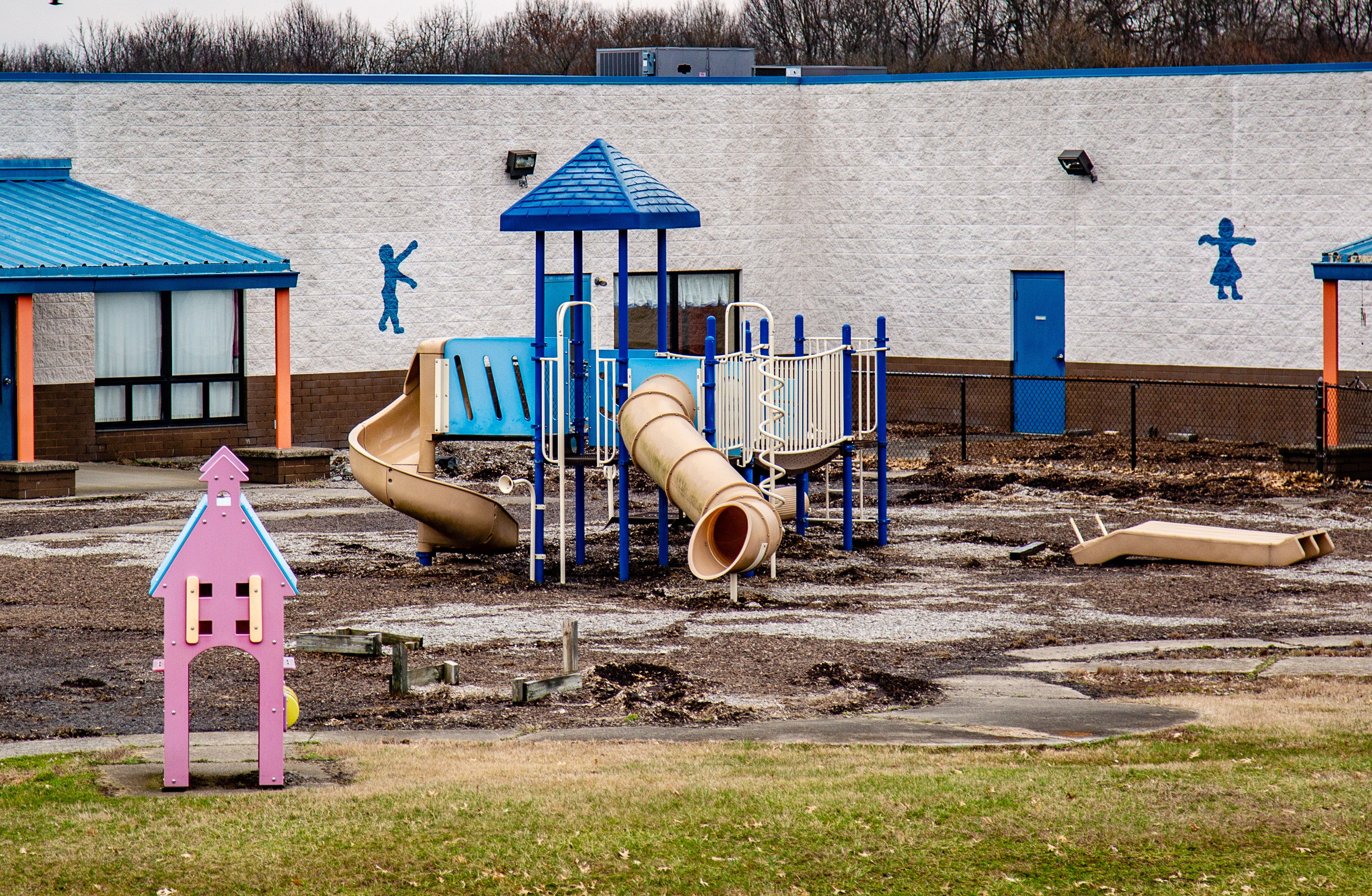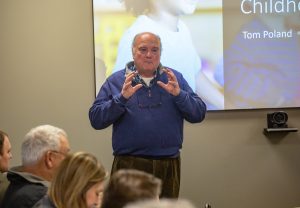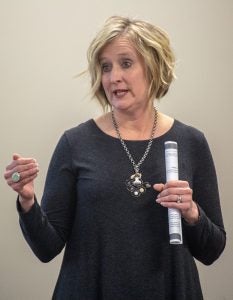White paper: Boyle County is a ‘child care desert’
Published 8:09 pm Thursday, February 21, 2019

- Ben Kleppinger/ben.kleppinger@amnews.com The main playground at the building that used to house A Children's Place day care is seen on Thursday afternoon from near the U.S. 127 Bypass in Danville.
Boyle County is a “child care desert” where more than half of kindergartners are not ready to learn, according to a white paper released this month by the Danville-Boyle Early Childhood Alliance.
If leaders can’t figure out how to add more slots for child care now, they may be stuck figuring out how to build more jail beds in the future, members of the alliance said this week.
The white paper makes eight recommendations for improving child care and education for Boyle’s youngest residents, including creating Boyle County-specific Head Start and Early Head Start programs.

Ben Kleppinger/ben.kleppinger@amnews.com
Tom Poland, a member of the Danville-Boyle Early Childhood Alliance, presents findings from the alliance’s newly released white paper to the Develop Danville Board of Directors Wednesday.
The Early Childhood Alliance says an estimated 150 infants and toddlers ages 0-2 would qualify for an Early Head Start program if Boyle County had one. There are currently 20 slots for 3- and 4-year-old Boyle children in the Mercer-Boyle Head Start program, but there are probably more than 100 in the county who qualify.
“From an economic standpoint, $1 invested in early childhood equates to $17 of a return on investment. That is a huge, huge statistic,” said Tom Poland, a member of the alliance. “To quote Bill Gates, the first five years are so important to the next 80.”
According to the white paper:
• There are 977 children ages 0-2 living in Boyle County, but only 202 full-time child care slots available, leading to the county’s classification as a “child care desert” because there are more than three children for every available child care slot.
• Of those infants and toddlers who attend child care, 68 percent go to “low-quality” facilities that are rated either one or two stars out of five on the state’s “All STARS” quality rating system.
• There are 663 child ages 3-4 in Boyle County, 316 of which could be served by existing child care providers.
• About 73 percent of the slots for 3- to 4-year-olds are at low-quality facilities.
The white paper also identifies several existing high-quality child care options available that only provide care for part of the day: preschool is available for 3- and 4-year-olds with disabilities and 4-year-olds from families living below 160-percent of the poverty line; and WIlderness Trace Child Development Center provides a “high-quality, part-time program for children aged 2-5 that provides educational and therapeutic services for 52 children with and without disabilities.”
And it identifies three no-cost services available for children who are being cared for at home:
• HANDS, a weekly home visitation program from the health department;
• Cradle School from Families First in the Danville Independent School District, which helps teach parents how to improve their children’s kindergarten readiness; and
• The Gladys Project, an early intervention literacy program that helps parents develop their children’s pre-literacy skills.
Amy Longwill, a member of the Early Childhood Alliance, said high-quality child care options are essential for developing children’s ability to learn in the future.
“You spend your first year at school learning to read, but when you get to third grade, you begin to read to learn,” Longwill said. “And if you’re not ready to read to learn in third grade, then you are going to be further and further behind each and every year afterward. It’s kind of the domino effect going backwards.”
Longwill said students who aren’t ready for kindergarten have a “very, very slim” chance of catching up and being on grade level by third grade. The repercussions follow students all the way into adulthood, and the community ultimately winds up paying a price, as well.
“We’re going to pay for this on one end or the other,” Longwill said. “We can choose to invest in our children and early learning opportunities now, or we can pay a whole lot more when we get to the other end.”

Ben Kleppinger/ben.kleppinger@amnews.com
Amy Longwill, a member of the Danville-Boyle Early Childhood Alliance, talks about the importance of early childhood education to future success during a presentation to the Develop Danville Board of Directors Wednesday.
Many states actually use their third-grade reading levels to predict how many prison beds they will need in the future she said. “We can plan for prison beds, or we can get our kids ready.”
Poland noted local government already spends a lot of money on its jail, referring to the chronically overcrowded Boyle County Detention Center and officials’ efforts to control costs and reduce the inmate population.
“If we could just spend a little money on this, it would be a great return on investment,” he said.
Patten Mahler, a Centre College professor and another leader of the alliance, said the goal is not to provide a child care slot for every single child, because there are naturally many children who are cared for in their homes until they go to school. But Boyle County is a full 125 slots short of national average of one slot for every three children ages 0-2.
For children ages 3-4, there are more slots available, but there’s also a lot more children who are enrolled in part-day programs, meaning parents need help with child care the other half of the day — and with transporting their children between child care locations, Mahler said.
The white paper’s recommendations call for Boyle County to increase its child care capacity for 0- to 2-year-olds by “removing barriers for providers who want to expand their services and supporting new services.” The most common barriers are “space and staffing.”
It also recommends increasing “wrap-around services” for 3- to 4-year-olds, like Mahler talked about — child care available before and after part-day educational programs and transportation between. “This would allow working parents to take advantage of high-quality early childhood education services.”
The white paper recommends bringing Head Start and Early Head Start programs to Boyle County “by partnering with Bluegrass Community Action Partnership, the grantee of federal funding for Boyle County Head Start.”
It also recommends bringing “the price of care in-line with the value of services provided.”
The cost per day for child care in Boyle County is less than what it costs elsewhere: “The median price for full-time infant care in Boyle County is $22/day, below the median prices in rural ($25) and urban ($30) areas in central Kentucky,” according to the white paper. For children ages 3-4, “the median price in Boyle County is $20.50 a day, below the median price in rural ($23) and urban ($27) areas in Kentucky.”
“As prices rise,” the white paper recommends that Boyle County “develop ways to subsidize the cost of care to ensure low-income families have access to services.”
The white paper makes several other recommendations:
• increase quality across the board by providing training and growing the number of graduates from local colleges in the area of early childhood education.
• “Strengthen community understanding” the problem and the importance of early childhood education.
• “Develop a collaborative network of early childhood and family services.”
• “Promote the continued diversity within provider settings so the children from different backgrounds learn and grow together.”
The Early Childhood Alliance was formed last year, after Ephraim McDowell Health announced it would be shutting down A Children’s Place, the largest child care facility in the county. A Children’s Place had provided 120 slots, many of them to children with parents working at Boyle County businesses. The alliance includes representatives from public schools, health care, local churches, local government leaders, the Early Childhood Council and higher education, as well as community members and parents.
Poland said in the time the alliance has been around, a lot of good things have been going on, and the community needs to continue to “be bold.”
“To be the community we’re all about, we need to look to the future.”




